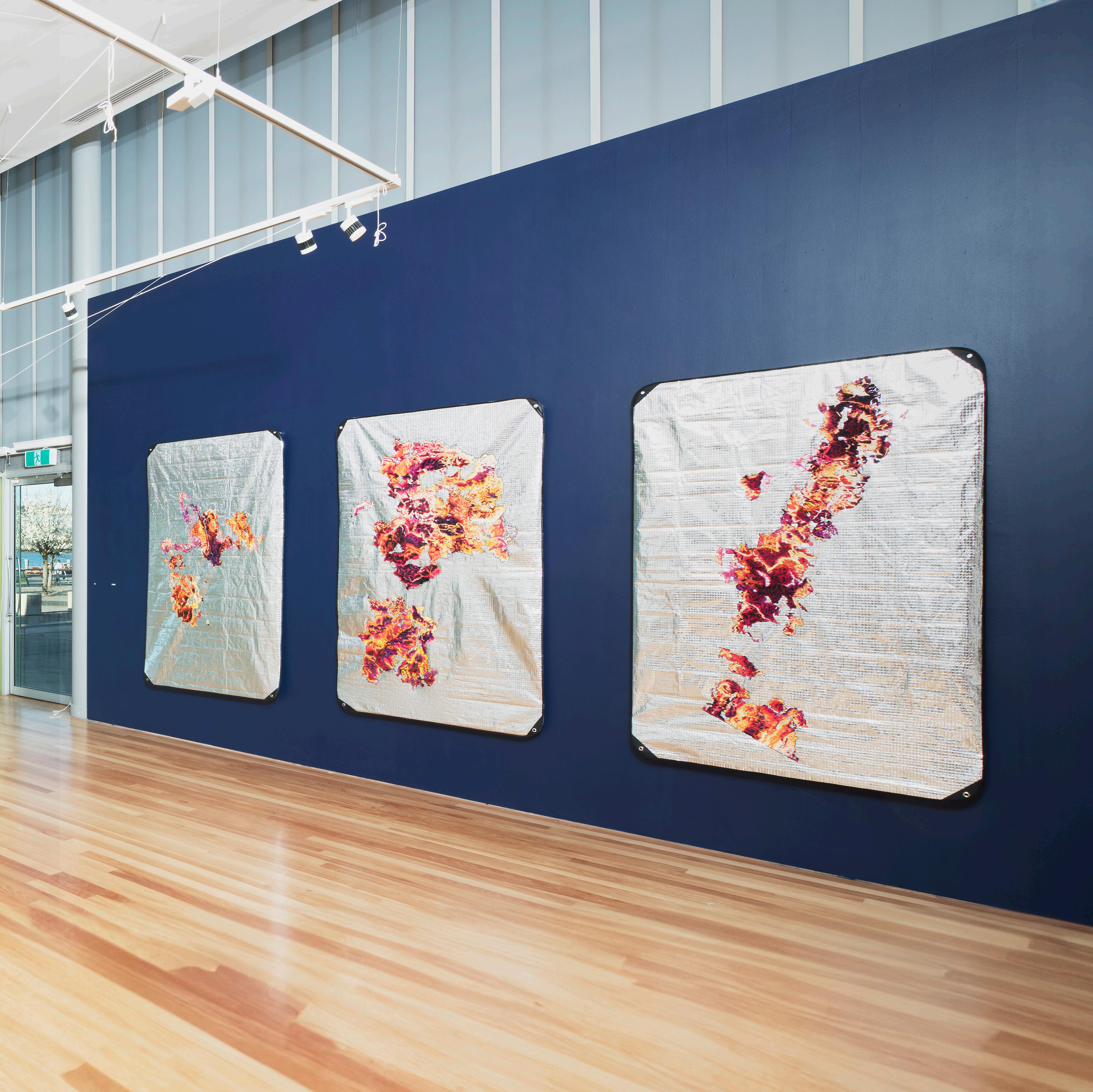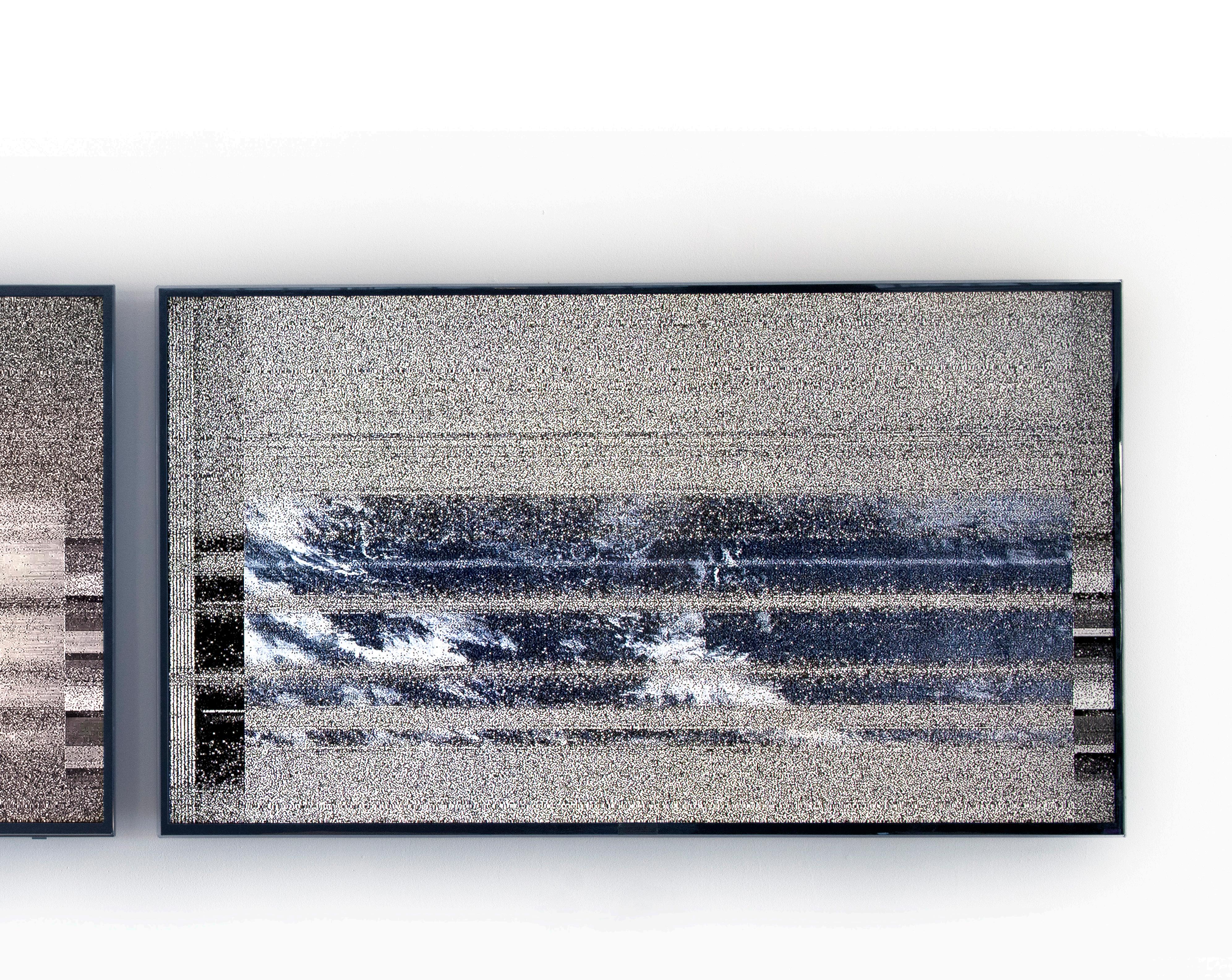SIGNAL TO NOISE
ANNA MADELEINE RAUPACH
 Image ANNA MADELEINE RAUPACH
Sent to the sky, received from the stars (detail) 2023 Cyanotype on parachute, nylon, silk, dimensions variable
Photograph: Brenton McGeachie
- Jan Zalasiewicz, The Earth after Us 1
Image ANNA MADELEINE RAUPACH
Sent to the sky, received from the stars (detail) 2023 Cyanotype on parachute, nylon, silk, dimensions variable
Photograph: Brenton McGeachie
- Jan Zalasiewicz, The Earth after Us 1
Caught Within A Private Universe
How do we image the climate crisis? The problem is complex. Firstly, it is multi-temporal, situated across vast scales of time, both at once as slow in its gestation as tectonic movement and as urgently present as a bushfire. Secondly, it is excessive in its physical and emotional registers – how does one describe something that frequently exceeds human sensorial capacity? In the face of its enormity, art feels minute, at points indulgent. Persisting seems Sisyphean. But when our mediums for scientific interpreting struggle, and when measurement is most vital, that is precisely when feeling and relating through it becomes critical. As historian Dipesh Chakrabarty puts it, ‘when a science speaks to urgency, it has to go beyond science—and that’s the humanities. So I think the question of affect is absolutely important.’ 2 Typically, as I have argued elsewhere, 3 when we think of climate crisis, a common affective response is what Sianne Ngai calls stuplimity: a conflation of both the stupefying (unable to think or feel, shocked) and sublime (extreme, beyond description, in awe). I understand Ngai’s term through my own responses to the reverberations of the planet; faced by its rupture I look away, clam up, can’t hear, dissociate. It is all too much, somehow both shutting down and maxing out – that, to me, is the stuplime. How then do we find better ways to image crisis and harness our affective relationships with the planet?
Kamberri-based Anna Madeleine Raupach’s art links the personal with the planetary and the scientific with the poetic. The works presented here articulate the value found at these intersections. The heart of Signal to Noise—the title itself speaks to a corrupted process of information transferral—is Sent to the sky, received from the stars (2023) a full-sized military-issue parachute, its extended canopy becoming a sheltering sub-structure within CCAS. Its form denotes multiple references. At first, rescue, safe descent; then more obliquely, the shape of a planetarium’s roof, the patterning of a geodesic dome, a hemisphere of Lewis Fry Richardson’s Forecast Factory. 4 As I look more, my associations become more embodied. I imagine the sound of a rip cord being pulled, the rapid billowing of reams of fabric exiting a tightly-bound bag strapped to my back. Air slapping my cheeks, my face rippling as I plummet and the sudden, violent jerking of my body as the air bulges the material to its full, taut extremity. And then, a peaceful vantage point; dangling in the mid-atmosphere. A vast perspective of the planet uncommon and god-like, as if my body were a satellite. The work places us there, if only in the mind’s eye.
Like this imagined peace that follows the chute’s full unfurling, the experience of Sent to the sky, received from the stars in the gallery is serene; a quiet majesty. This calm troubles the satellite’s omnipotent view. The satellite looms frequently in Raupach’s practice, but always as an ambivalent beast. Here the artist has drawn its particular perspective into dialogue with the opposing view of the telescope or antenna:
‘It is hard, as humans, to have a perspective on the human race.’
 Image ANNA MADELEINE RAUPACH
Slow Violence (Eastern Victoria) 2022
Embroidery thread on emergency blanket, 127 x 200cm
Photograph: Brenton McGeachie
Image ANNA MADELEINE RAUPACH
Slow Violence (Eastern Victoria) 2022
Embroidery thread on emergency blanket, 127 x 200cm
Photograph: Brenton McGeachie
making a hybrid sight, one eye to the earth and the other to the heavens. The chute’s panels have been replaced intermittently with panes of blue, like Raupach has taken a blade to the sky. Rather than streaks of cloud, the white amongst its ultramarine is a mixture of images, imprinted on the fabric’s surface by the sun’s light as a cyanotype: satellite streaks obstructing astronomic data of the night sky as well as the visual conversion of weather probe data with an earthbound antenna. In the accompanying video work Global Commons / Private Universe (2023), the two are melded together to create a dual view towards space and also down through weather systems, sensed by air-based infrastructure. Connecting the two is the viewer – strung like a cord tethering the earth to the cosmos, sensing too, like the satellite or probe, in their own unique way. Afterall, data is meant to help us understand the world better – we each gather sensorial data as we move throughout the world, and interpreting this is crucial. Though feelings are not facts, their presence and harnessing is vital to the planetary present, human action on climate crisis, and our livelihoods amongst it. For example, if geoengineering’s solution to a rapidly warming planet is taken up—spraying aerosols in the stratosphere to reflect light—then the sky will permanently be the same colour as the parachute’s other panes: white. As Chakrabarty retorts: ‘do you want to live with white skies?’ 5
Hanging on the opposing walls is Slow Violence (2020–22), a suite of four, hand-embroided emergency blankets. Similar to Sent to the sky, received from the stars, which shows Raupach’s intensive, handsewn process in its inserted cyanotype panes, Slow Violence continues the presence of craft-based processes enmeshed within the data of climate crisis. Here, these works draw on satellite information freely accessible during Black Summer – the vast bushfires that beset the continent from late 2019 to early 2020. The making of these works extended past the fires’ final quelling and into the equally heightened but deadened expanse of the COVID-19 pandemic. Looking to occupy her hands and mind, Raupach began embroidering. A different yet still vital processing takes place in their making: cold data is transferred through the maker, methodically woven to create sensitive maps of physical and emotional conflagration. The act of their making simultaneously destroys (punctures) and repairs (binds) the fabric. This collision of goodwill and destruction in one reflects the repeating loop of the public body at a time of crisis – while one hand mends, the other tears.
Tim Riley Walsh
August 2023
Notes
1. Jan Zalasiewicz, The Earth after Us: What Legacy Will Humans Leave in the Rocks? (Oxford: Oxford UP, 2008), 1.
2. Doron Darnov, “Mapping the Planetary: Five Questions for Dipesh Chakrabarty,” EdgeEffects, 30 March, 2021, https://edgeeffects.net/dipesh-chakrabarty-planetary/.
3. Tim Riley Walsh, ed. On Fire: Climate & Crisis (Brisbane: Institute of Modern Art, 2021).
4. James Bridle, New Dark Age: Technology and the End of the Future (London: Verso Books, 2018) 20-23.
5. Darnov, “Mapping the Planetary”.
Tim Riley Walsh is Assistant Curator, Museum of Contemporary Art Australia, Sydney, and is based on the lands of the Gadigal people of the Eora Nation.
 Image ANNA MADELEINE RAUPACH
Sent to the sky, received from the stars 2023 Cyanotype on parachute, nylon, silk, dimensions variable
Photograph: Brenton McGeachie
Image ANNA MADELEINE RAUPACH
Sent to the sky, received from the stars 2023 Cyanotype on parachute, nylon, silk, dimensions variable
Photograph: Brenton McGeachie

 Above ANNA MADELEINE RAUPACH
Sent to the sky, received from the stars 2023 Cyanotype on parachute, nylon, silk, dimensions variable
Photograph: Brenton McGeachie
Above ANNA MADELEINE RAUPACH
Sent to the sky, received from the stars 2023 Cyanotype on parachute, nylon, silk, dimensions variable
Photograph: Brenton McGeachie
Slow Violence (Orroral Valley) 2021
Embroidery
Centre ANNA MADELEINE RAUPACH

Slow Violence (Gospers Mountain) 2020
Embroidery
Slow Violence (South Coast) 2022
Embroidery
Left ANNA MADELEINE RAUPACH
thread on emergency blanket, 200 x 127cm
thread on emergency blanket, 200 x 127cm
Right ANNA MADELEINE RAUPACH
thread on emergency blanket, 200 x 127cm


Global Commons / Private Universe 2023
Multi-channel video, 4’00’’ loop
 Image ANNA MADELEINE RAUPACH
Photograph: Brenton McGeachie
Image ANNA MADELEINE RAUPACH
Photograph: Brenton McGeachie

 Image ANNA MADELEINE RAUPACH
Satellite Cyanotypes 2020
Animated cyanotypes, 0’54’’ loop
Photograph: Brenton McGeachie
Image ANNA MADELEINE RAUPACH
Satellite Cyanotypes 2020
Animated cyanotypes, 0’54’’ loop
Photograph: Brenton McGeachie



 Image ANNA MADELEINE RAUPACH
Sent to the sky, received from the stars (detail) 2023 Cyanotype on parachute, nylon, silk, dimensions variable
Photograph: Brenton McGeachie
- Jan Zalasiewicz, The Earth after Us 1
Image ANNA MADELEINE RAUPACH
Sent to the sky, received from the stars (detail) 2023 Cyanotype on parachute, nylon, silk, dimensions variable
Photograph: Brenton McGeachie
- Jan Zalasiewicz, The Earth after Us 1
 Image ANNA MADELEINE RAUPACH
Slow Violence (Eastern Victoria) 2022
Embroidery thread on emergency blanket, 127 x 200cm
Photograph: Brenton McGeachie
Image ANNA MADELEINE RAUPACH
Slow Violence (Eastern Victoria) 2022
Embroidery thread on emergency blanket, 127 x 200cm
Photograph: Brenton McGeachie
 Image ANNA MADELEINE RAUPACH
Sent to the sky, received from the stars 2023 Cyanotype on parachute, nylon, silk, dimensions variable
Photograph: Brenton McGeachie
Image ANNA MADELEINE RAUPACH
Sent to the sky, received from the stars 2023 Cyanotype on parachute, nylon, silk, dimensions variable
Photograph: Brenton McGeachie

 Above ANNA MADELEINE RAUPACH
Sent to the sky, received from the stars 2023 Cyanotype on parachute, nylon, silk, dimensions variable
Photograph: Brenton McGeachie
Above ANNA MADELEINE RAUPACH
Sent to the sky, received from the stars 2023 Cyanotype on parachute, nylon, silk, dimensions variable
Photograph: Brenton McGeachie



 Image ANNA MADELEINE RAUPACH
Photograph: Brenton McGeachie
Image ANNA MADELEINE RAUPACH
Photograph: Brenton McGeachie

 Image ANNA MADELEINE RAUPACH
Satellite Cyanotypes 2020
Animated cyanotypes, 0’54’’ loop
Photograph: Brenton McGeachie
Image ANNA MADELEINE RAUPACH
Satellite Cyanotypes 2020
Animated cyanotypes, 0’54’’ loop
Photograph: Brenton McGeachie

